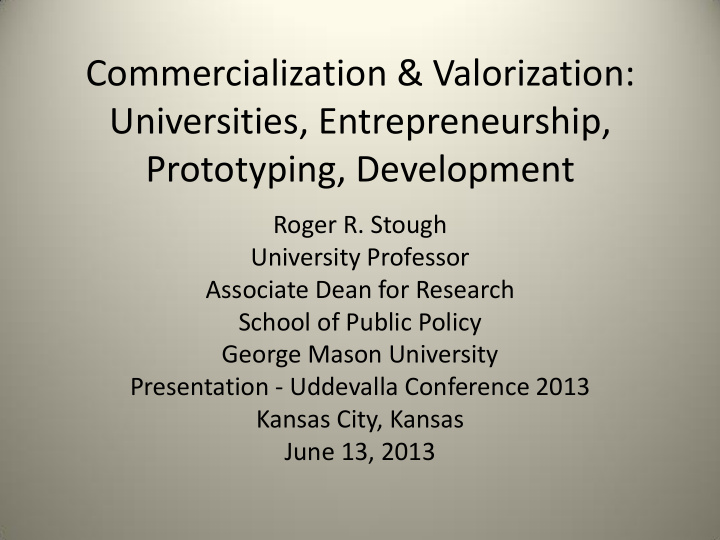



Commercialization & Valorization: Universities, Entrepreneurship, Prototyping, Development Roger R. Stough University Professor Associate Dean for Research School of Public Policy George Mason University Presentation - Uddevalla Conference 2013 Kansas City, Kansas June 13, 2013
Commercialization & Valorization • Commercialization most used in the U.S. • Valorization recent term; used in Europe • Why? – Commercialization pathway to value is market – Valorization: there are non-market pathways • Culture?
Role of Universities in Society • Teaching • Create new & economically useful knowledge • Create societal benefits – Products – Services – Quality of life and social existence
University Missions • Education • Research [& Economic Development] • Public Service
The Education Mission • Teaching – Knowledge transfer – Career preparation – internships; practicums – Placement – Continuing education – executive education – Workforce development – economic development – Societal maintenance – Adopting & adapting new technology – distance education
The Public Service Mission • Social benefits – Community development – Philanthropy – Job creation – Institutional maintenance – Cultural maintenance – Child rearing – de Tocqueville - American Exceptionalism
The R & D Mission • Basic research – creating new knowledge • Applied research – the D in R&D – Intellectual property: patents – Prototypes – Licenses – Company formation and facilitation • Economic Development – Jobs – Income – Wealth – New firms
Research Definitions & Outcomes Research as New Basic Knowledge Enquiry Companies Jobs Income Wealth Translation of Research as New Development Prototypes & Applied Licenses Existing Translational Patents Knowledge Research
University Stress/Opportunity Factors: Education Mission • Technical innovation → distance education • Reduced financial support → cost cutting? • Increasing demand from emerging economies • Catalytic role of R&D and economic development
Response to University Stress/Opportunity Factors – R&D • Catalytic role of increasing research & economic development – Grows the market – Creates things that industry wants or needs – Builds intellectual property & possibility for equity & cashing out in the M&A market – Creates a feedback loop that stimulates demand for education services – Raises prestige & donor awards – Contributes to job, income & wealth creation
Competitive Factors in the Global Economy • IT revolution • Knowledge & Information Age • Changing theories of Economic Development • The emerging economies – Labor cost and reverse engineering based competition • How to off-set labor cost advantage &reverse engineering advantages of emergent economies? • Rapid & continuous innovation
Examples from Public & Private Universities in Developed Countries • Rapid Equipping Force – U.S. Army • Highly time-compressed software innovation • University Application opportunities – Distance & executive education; and, rapid prototyping • Rapid & continuous innovation important for private sector? • One of the few ways to compete – Cannot protect digital knowledge; – Others access digital knowledge & rapidly reengineer it – & achieve significant labor cost advantages • Must innovate faster than reengineering can occur – Easier to do for technical & complex goods & services
Conclusions • Universities: market stress & opportunities – Distance & executive education – Research & economic development mission – How will universities be different? Or the same? • Rapid & continuous innovation only way for developed economies to compete? • A role for Universities – pioneer rapid innovation & transform R&d to r&D!
Some Pathways for the Future • Promote development based research (applied & translational research),entrepreneurship, commercialization and innovation in universities • Promote social entrepreneurship and “public sector entrepreneurship”: operationalizing the concept of valorization? • Operationalize the concepts of commercialization and valorization?
Planning for r&D Future • Find or acquire faculty that can do R&D -most can do R; some can do D • Identify R&D clusters of expertise – Need to know areas of specialization for the university or the unit – Network analyses of faculty expertise and ties to each other (see next slides for an example) – Incentivise “D”, e.g., create infrastructure & related rewards (see last slide for an example)
Secure Floor Prototyping & Applied Research External and internal support Support for Growth Companies – A ”Company Factory” - Access to Suites • Founders Corp - -Tech Transfer Office • Mason Enterprise Center • Social Entrepreneurship Center • Management Support for Lean & • Engineering Micro Entrepreneurship • Research Office & Outrearch : Training Workshops and Class Rooms
Thank You Roger R. Stough [rstough@gmu.edu]
Recommend
More recommend